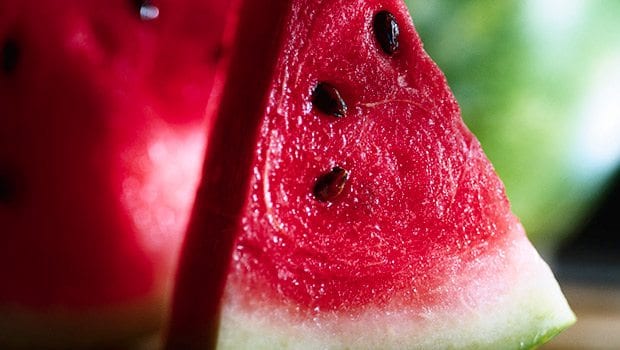Watermelon: A combination of water and healthy nutrients
July is National Watermelon Month

Here’s a tip on how to get a dose of water and lycopene in one hit. Eat some watermelon. The water part is easy to understand — the name says it all. Watermelon is more than 91 percent water. That’s what makes it so refreshing as well as thirst-quenching.
The lycopene part is less well known. Lycopene is a powerful antioxidant, a chemical that destroys dangerous free radicals, those errant molecules that can damage DNA and other fragile cell structures. Some studies suggest that eating foods high in lycopene may reduce the risk of cancer — particularly prostate cancer — heart disease and age-related eye disorders.
It is lycopene that gives watermelon its red color. The deeper the red, the higher the content of the antioxidant. Lycopene is also found in tomatoes, guava and pink grapefruit. While tomatoes have always been touted as the major food source of lycopene, it’s the heated tomato — as in tomato sauce or paste — that enhances the concentration and absorption of lycopene. Raw tomatoes are less well endowed. However, it’s been discovered that on average watermelon has about 40 percent more lycopene than raw tomatoes.
As noted in the nutrition facts of fruit published by the U.S. Food and Drug Administration, watermelon has a lot more going for it than just water and lycopene. A two-cup serving has a scant 80 calories and is considered fat, cholesterol and sodium-free.
More importantly, watermelon is a good source of vitamins A and C, and potassium. Vitamin A contributes to the strength of the immune system, while Vitamin C is needed for the growth and repair of tissues in all parts of the body. Potassium is a mineral that helps nerves and muscles communicate. A diet rich in potassium, when coupled with low sodium, helps maintain normal blood pressure.
So significant is watermelon to one’s health and the agricultural industry in this country that in 2007, the U.S. Senate unanimously passed a resolution that designates July as National Watermelon Month.
Choosing the best melon is often hit or miss. The National Watermelon Promotion Board offers a few pointers. Look for ones that are heavy for its size. Remember, watermelons are mostly water. Choose symmetrical melons with a dried stem and yellowish underside.
Although the rind protects the fruit, one can’t be sure what’s lurking on the outside. The melon may be harboring residue from herbicides and pesticides. The Food and Drug Administration advises washing the rind before carving. A quick cleaning will eliminate the chance of transferring germs to the inside when you cut into it.
While health professionals often fall flat trying to convince the public to eat healthy, watermelon is an easy sell. It tastes good and is good for you.

Watermelon Strawberry Shake
Ingredients
- One container (8 ounces) lemon nonfat yogurt
- 2 cups cubed, seeded watermelon
- 1 pint fresh strawberries, cleaned and hulled
- 1 medium sliced banana
Directions
In a blender or food processor, mix yogurt, watermelon, strawberries and banana until smooth and frothy. Serve immediately.
Makes 4 servings
Per serving:
Calories: 112
Total fat: 1 g
Carbohydrates: 25 g
Dietary fiber: 2 g
Protein: 4 g
Fiber: 2 g
Sodium: 16 mg
Recipe courtesy of National Watermelon Promotion Board


![Banner [Virtual] Art Gallery](https://baystatebanner.com/wp-content/uploads/2024/04/Cagen-Luse_Men-at-store-e1713991226112-150x150.jpg)



